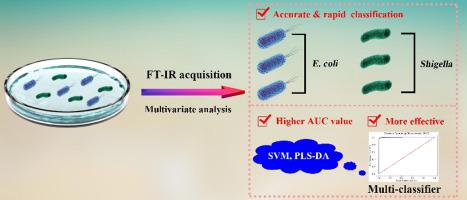Spectrochimica Acta Part A: Molecular and Biomolecular Spectroscopy ( IF 4.3 ) Pub Date : 2022-05-11 , DOI: 10.1016/j.saa.2022.121369 Bin Feng 1 , Hao Shen 1 , Fan Yang 2 , Jintao Yan 1 , Shouning Yang 1 , Ning Gan 1 , Haimei Shi 1 , Shaoning Yu 1 , Li Wang 2

|
Accurate and effective discrimination of E. coli and Shigella is an important clinical issue, and there are many limitations in traditional methods of analysis. FT-IR shows great potential in the classification of bacteria with high specificity and low cost. In this study, we evaluated the efficiency of this technique when combined with multivariate analysis for rapid classification of E. coli and Shigella, which is difficult using traditional analytical methods. Machine learning and statistical tools were employed in combination with FT-IR to classify 14 E. coli and 9 Shigella strains. The classification accuracies for select E. coli and Shigella strains from blood agar were 0.7826, 0.8696, and 0.9565 at the genus, species, and strain levels, respectively. In addition, we used the FT-IR data of select strains from three different culture media for cross-validation, yielding an accuracy of 0.3681 at the strain level. These results indicate that the bacterial culture conditions have a significant impact on the FT-IR patterns. Based on this, an improved strategy for training an ensemble classifier model considering bacterial culture factors was constructed, resulting in almost perfect separation with an accuracy of 0.9394 for strain-level classification. These results show the potential of FT-IR combined with multivariate analysis for more reliable bacterial classification.
中文翻译:

使用 FT-IR 光谱和多变量分析对大肠杆菌和志贺氏菌进行有效分类
准确有效地鉴别大肠杆菌和志贺氏菌是一个重要的临床问题,传统的分析方法存在许多局限性。FT-IR在细菌分类方面显示出巨大的潜力,具有高特异性和低成本。在这项研究中,我们评估了该技术与多变量分析相结合的效率,用于快速分类大肠杆菌和志贺氏菌,这是使用传统分析方法难以实现的。机器学习和统计工具与 FT-IR 结合使用,对 14种大肠杆菌和 9种志贺氏菌菌株进行分类。选择大肠杆菌的分类准确度和来自血琼脂的志贺氏菌在属、种和菌株水平上分别为 0.7826、0.8696 和 0.9565。此外,我们使用来自三种不同培养基的选定菌株的 FT-IR 数据进行交叉验证,在菌株水平上产生了 0.3681 的准确度。这些结果表明,细菌培养条件对 FT-IR 模式有显着影响。在此基础上,构建了一种考虑细菌培养因素的集成分类器模型训练改进策略,实现了近乎完美的分离,菌株级分类精度为 0.9394。这些结果显示了 FT-IR 与多变量分析相结合的潜力,可实现更可靠的细菌分类。











































 京公网安备 11010802027423号
京公网安备 11010802027423号